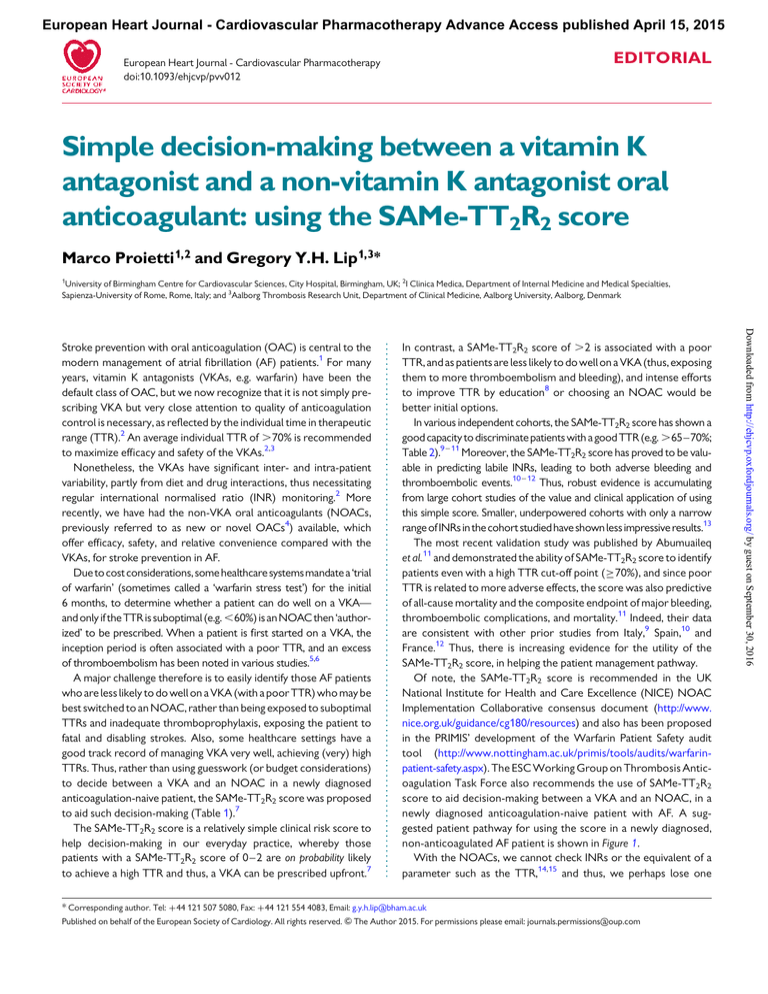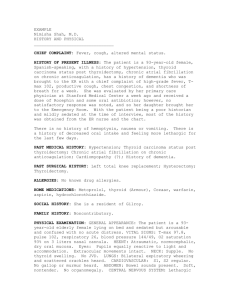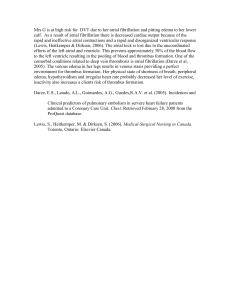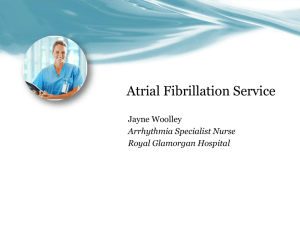
European Heart Journal - Cardiovascular Pharmacotherapy Advance Access published April 15, 2015
EDITORIAL
European Heart Journal - Cardiovascular Pharmacotherapy
doi:10.1093/ehjcvp/pvv012
Simple decision-making between a vitamin K
antagonist and a non-vitamin K antagonist oral
anticoagulant: using the SAMe-TT2R2 score
Marco Proietti 1,2 and Gregory Y.H. Lip 1,3*
1
University of Birmingham Centre for Cardiovascular Sciences, City Hospital, Birmingham, UK; 2I Clinica Medica, Department of Internal Medicine and Medical Specialties,
Sapienza-University of Rome, Rome, Italy; and 3Aalborg Thrombosis Research Unit, Department of Clinical Medicine, Aalborg University, Aalborg, Denmark
In contrast, a SAMe-TT2R2 score of .2 is associated with a poor
TTR, and as patients are less likely to do well on a VKA (thus, exposing
them to more thromboembolism and bleeding), and intense efforts
to improve TTR by education8 or choosing an NOAC would be
better initial options.
In various independent cohorts, the SAMe-TT2R2 score has shown a
good capacity to discriminate patients with a good TTR (e.g. .65–70%;
Table 2).9 – 11 Moreover, the SAMe-TT2R2 score has proved to be valuable in predicting labile INRs, leading to both adverse bleeding and
thromboembolic events.10 – 12 Thus, robust evidence is accumulating
from large cohort studies of the value and clinical application of using
this simple score. Smaller, underpowered cohorts with only a narrow
range of INRs in the cohort studied have shown less impressive results.13
The most recent validation study was published by Abumuaileq
et al. 11 and demonstrated the ability of SAMe-TT2R2 score to identify
patients even with a high TTR cut-off point (≥70%), and since poor
TTR is related to more adverse effects, the score was also predictive
of all-cause mortality and the composite endpoint of major bleeding,
thromboembolic complications, and mortality.11 Indeed, their data
are consistent with other prior studies from Italy,9 Spain,10 and
France.12 Thus, there is increasing evidence for the utility of the
SAMe-TT2R2 score, in helping the patient management pathway.
Of note, the SAMe-TT2R2 score is recommended in the UK
National Institute for Health and Care Excellence (NICE) NOAC
Implementation Collaborative consensus document (http://www.
nice.org.uk/guidance/cg180/resources) and also has been proposed
in the PRIMIS’ development of the Warfarin Patient Safety audit
tool (http://www.nottingham.ac.uk/primis/tools/audits/warfarinpatient-safety.aspx). The ESC Working Group on Thrombosis Anticoagulation Task Force also recommends the use of SAMe-TT2R2
score to aid decision-making between a VKA and an NOAC, in a
newly diagnosed anticoagulation-naive patient with AF. A suggested patient pathway for using the score in a newly diagnosed,
non-anticoagulated AF patient is shown in Figure 1.
With the NOACs, we cannot check INRs or the equivalent of a
parameter such as the TTR,14,15 and thus, we perhaps lose one
* Corresponding author. Tel: +44 121 507 5080, Fax: +44 121 554 4083, Email: g.y.h.lip@bham.ac.uk
Published on behalf of the European Society of Cardiology. All rights reserved. & The Author 2015. For permissions please email: journals.permissions@oup.com
Downloaded from http://ehjcvp.oxfordjournals.org/ by guest on September 30, 2016
Stroke prevention with oral anticoagulation (OAC) is central to the
modern management of atrial fibrillation (AF) patients.1 For many
years, vitamin K antagonists (VKAs, e.g. warfarin) have been the
default class of OAC, but we now recognize that it is not simply prescribing VKA but very close attention to quality of anticoagulation
control is necessary, as reflected by the individual time in therapeutic
range (TTR).2 An average individual TTR of .70% is recommended
to maximize efficacy and safety of the VKAs.2,3
Nonetheless, the VKAs have significant inter- and intra-patient
variability, partly from diet and drug interactions, thus necessitating
regular international normalised ratio (INR) monitoring.2 More
recently, we have had the non-VKA oral anticoagulants (NOACs,
previously referred to as new or novel OACs4) available, which
offer efficacy, safety, and relative convenience compared with the
VKAs, for stroke prevention in AF.
Due to cost considerations, some healthcare systems mandate a ‘trial
of warfarin’ (sometimes called a ‘warfarin stress test’) for the initial
6 months, to determine whether a patient can do well on a VKA—
and only if the TTR is suboptimal (e.g. ,60%) is an NOAC then ‘authorized’ to be prescribed. When a patient is first started on a VKA, the
inception period is often associated with a poor TTR, and an excess
of thromboembolism has been noted in various studies.5,6
A major challenge therefore is to easily identify those AF patients
who are less likely to do well on a VKA (with a poor TTR) who may be
best switched to an NOAC, rather than being exposed to suboptimal
TTRs and inadequate thromboprophylaxis, exposing the patient to
fatal and disabling strokes. Also, some healthcare settings have a
good track record of managing VKA very well, achieving (very) high
TTRs. Thus, rather than using guesswork (or budget considerations)
to decide between a VKA and an NOAC in a newly diagnosed
anticoagulation-naive patient, the SAMe-TT2R2 score was proposed
to aid such decision-making (Table 1).7
The SAMe-TT2R2 score is a relatively simple clinical risk score to
help decision-making in our everyday practice, whereby those
patients with a SAMe-TT2R2 score of 0–2 are on probability likely
to achieve a high TTR and thus, a VKA can be prescribed upfront.7
Page 2 of 3
Table 1
Editorial
SAMe-TT2R2 score
Definitions
Points
................................................................................
S
Sex (female)
1
A
Me
Age (,60 years)
Medical historya
1
1
T
Treatment (interacting drugs, e.g.
amiodarone for rhythm control)
1
T
Tobacco use (within 2 years)
2
R
Maximum
points
Race (non-Caucasian)
2
8
a
More than two of the following: hypertension, diabetes, coronary artery disease/
myocardial infarction, peripheral arterial disease, congestive heart failure, previous
stroke, pulmonary disease, and hepatic or renal disease.
SAMe-TT2R2 validation studies
Study design
Patients
Follow-up time
SAMe-TT2R2 distribution
Retrospective
1305 AF
NA
Score 0–1: 655 pts
Score 2: 303 pts
Score .2: 347 pts
Skov et al.13
Prospective
182
1 year
Score 0–1: 105
Score ≥2: 77
Poli et al.9
Prospective
1089 AF
4.6 years (mean)
Gallego et al.10
Prospective
972 NVAF
952 days (median)
Score 0–1: 624 pts
Score 2: 288 pts
Score .2: 177 pts
Score 0–1: 431 pts
Score 2: 332 pts
Score .2: 208 pts
Lip et al.12
Prospective
8120 AF
1016 days (mean)
...............................................................................................................................................................................
Apostolakis et al.
7
Score 0–1: 4504 pts
Score 2: 2252 pts
Score .2: 1364 pts
AF, atrial fibrillation; NA, not applicable; NVAF, non-valvular atrial fibrillation; pts, patients.
Figure 1 Using the SAMe-TT2R2 score in a patient pathway. VKA, vitamin K antagonist; NOAC, non-VKA oral anticoagulant.
Downloaded from http://ehjcvp.oxfordjournals.org/ by guest on September 30, 2016
Table 2
powerful tool to predict anticoagulation quality in AF patients. Could
the SAMe-TT2R2 score achieve more beyond the prediction of TTR
cut-off points, perhaps by being a ‘TTR surrogate’ that informs the
clinical likelihood of achieving good quality anticoagulation control,
in a patient started on an NOAC? Further studies are needed to
test this hypothesis.
We can certainly encourage further observational studies planned
to evaluate the predictive power of SAMe-TT2R2 score, both in its
original and revised form, in predicting major bleeding and thromboembolic complications, even beyond TTR assessment. A prospective
randomized trial, evaluating the impact of SAMe-TT2R2 score-guided
therapy with VKA or NOAC, would also allow us to formalize its clinical utility, and is stated as a research recommendation in the 2014
NICE guidelines for AF.16 Ultimately, clinicians need simple clinical
tools to aid decision-making in everyday clinical practice, and not
rely on complex formulae based on multivariate models that were
derived from a specific selected population or a trial cohort. The
Editorial
SAMe-TT2R2 score may offer that clinical utility for us, rather than
relying on guesswork.
References
7. Apostolakis S, Sullivan RM, Olshansky B, Lip GY. Factors affecting quality of anticoagulation control among patients with atrial fibrillation on warfarin: the SAMe-TT2R2
score. Chest 2013;144:1555 –1563.
8. Clarkesmith DE, Pattison HM, Lip GY, Lane DA. Educational intervention improves
anticoagulation control in atrial fibrillation patients: the TREAT randomised trial.
PLoS ONE 2013;8:e74037.
9. Poli D, Antonucci E, Testa S, Lip GY. A prospective validation of the SAME-TT2R2
score: how to identify atrial fibrillation patients who will have good anticoagulation
control on warfarin. Intern Emerg Med 2014;9:443 –447.
10. Gallego P, Roldán V, Marin F, Gálvez J, Valdés M, Vicente V, Lip GY. SAMe-TT2R2
score, time in therapeutic range, and outcomes in anticoagulated patients with
atrial fibrillation. Am J Med 2014;127:1083 – 1088.
11. Abumuaileq RR, Abu-Assi E, Raposeiras-Roubin S, López-López A, RedondoDiéguez A, Álvarez-Iglesias D, Rodrı́guez-Mañero M, Peña-Gil C, GonzálezJuanatey JR. Evaluation of SAMe-TT2R2 risk score for predicting the quality of
anticoagulation control in a real-world cohort of patients with non-valvular atrial
fibrillation on vitamin-K antagonists. Europace 2015; pii:euu353 [Epub ahead of print].
12. Lip GY, Haguenoer K, Saint-Etienne C, Fauchier L. Relationship of the SAMe-TT2R2
score to poor-quality anticoagulation, stroke, clinically relevant bleeding, and mortality in patients with atrial fibrillation. Chest 2014;146:719 –726.
13. Skov J, Bladbjerg EM, Bor MV, Gram J. SAMeTT2R2 does not predict time in therapeutic range of the international normalized ratio in patients attending a high-quality
anticoagulation clinic. Chest 2014;145:187 – 188.
14. Chan NC, Paikin JS, Hirsh J, Lauw MN, Eikelboom JW, Ginsberg JS. New oral anticoagulants for stroke prevention in atrial fibrillation: impact of study design, double
counting and unexpected findings on interpretation of study results and conclusions.
Thromb Haemost 2014;111:798 –807.
15. Schulman S. New oral anticoagulant agents—general features and outcomes in
subsets of patients. Thromb Haemost 2014;111:575 –582.
16. National Clinical Guideline Centre (UK). Atrial Fibrillation: The Management of
Atrial Fibrillation. London: National Institute for Health and Care Excellence
(UK), 2014.
Downloaded from http://ehjcvp.oxfordjournals.org/ by guest on September 30, 2016
1. Camm AJ, Lip GY, De Caterina R, Savelieva I, Atar D, Hohnloser SH, Hindricks G,
Kirchhof P; ESC Committee for Practice Guidelines (CPG). 2012 focused update
of the ESC Guidelines for the management of atrial fibrillation: an update of the
2010 ESC Guidelines for the management of atrial fibrillation. Developed with the
special contribution of the European Heart Rhythm Association. Eur Heart J 2012;
33:2719 –2747.
2. De Caterina R, Husted S, Wallentin L, Andreotti F, Arnesen H, Bachmann F,
Baigent C, Huber K, Jespersen J, Kristensen SD, Lip GY, Morais J, Rasmussen LH,
Siegbahn A, Verheugt FW, Weitz JI. Vitamin K antagonists in heart disease: current
status and perspectives (Section III). Position paper of the ESC Working Group
on Thrombosis—Task Force on Anticoagulants in Heart Disease. Thromb
Haemost 2013;110:1087 – 1107.
3. Gallego P, Roldan V, Marı́n F, Romera M, Valdés M, Vicente V, Lip GY. Cessation of
oral anticoagulation in relation to mortality and the risk of thrombotic events in
patients with atrial fibrillation. Thromb Haemost 2013;110:1189 –1198.
4. Husted S, de Caterina R, Andreotti F, Arnesen H, Bachmann F, Huber K, Jespersen J,
Kristensen SD, Lip GY, Morais J, Rasmussen LH, Siegbahn A, Storey RF, Weitz JI; ESC
Working Group on Thrombosis Task Force on Anticoagulants in Heart Disease.
Non-vitamin K antagonist oral anticoagulants (NOACs): no longer new or novel.
Thromb Haemost 2014;111:781–782.
5. Azoulay L, Dell’Aniello S, Simon TA, Renoux C, Suissa S. Initiation of warfarin in
patients with atrial fibrillation: early effects on ischaemic strokes. Eur Heart J 2014;
35:1881 –1887.
6. Tung JM, Mamdani MM, Juurlink DN, Paterson JM, Kapral MK, Gomes T. Rates of ischemic stroke during warfarin treatment for atrial fibrillation. Stroke 2015; doi:
10.1161/STROKEAHA.114.007852.
Page 3 of 3






